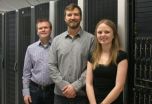(Press-News.org) Alexandria, Va., USA – Today during the 43rd Annual Meeting & Exhibition of the American Association for Dental Research, held in conjunction with the 38th Annual Meeting of the Canadian Association for Dental Research, Lauren Roper, University of Texas - San Antonio / Health Science Center, San Antonio, will present research titled "Adeno-Associated Virus Serotype-5 Delivery to the Rat Trigeminal Ganglion."
The objective of this study was to evaluate transduction efficiency of adeno-associated viruses (AAV) serotype-5 in trigeminal sensory system following a direct injection into the rat trigeminal ganglion (TG) by way of the infraorbital (IO) foramen at different survival times. Sections from TG, IO nerve and trigeminal sensory nuclei (TSN) from rats with AAV-5/CMV/chicken-beta-actin hybrid promoter with enhanced-Green Fluorescent Protein (GFP) transgene (Vector Biolabs; Philadelphia, PA) injected animals were evaluated with indirect immunofluorescence method and confocal microscopy following staining with GFP antibody.
Rats survived 2, 6 and 10 weeks (n=2/group). Viral particles delivered = 3x109 for 2 week subjects; 1.5x1010 for 6 and 10 week subjects. AAV-5 transduction, as detected by GFP staining, was present in the trigeminal system including TG sensory neurons, IO nerve peripheral processes and in central processes throughout the TSN, including the main sensory nucleus and trigeminal spinal nucleus, in 6 and 10 week survival subjects, but not in 2 week survival subjects.
Direct delivery of AAV-5 into TG sensory neurons can be accomplished by IO foramen injection and results in sensory neuron transduction including presence of protein (i.e. GFP) in peripheral and central processes. These results support the use of AAV-5 based gene therapy approaches to evaluate the role of target proteins and as a possible future treatment approach in trigeminal pain disorders.
INFORMATION:
This is a summary of abstract #1280, "Adeno-Associated Virus Serotype-5 Delivery to the Rat Trigeminal Ganglion," which will be presented on Friday, March 21, 2014, 3:30 p.m. – 4:45 p.m. at the Charlotte Convention Center, Exhibit Hall AB.
About the American Association for Dental Research
The American Association for Dental Research (AADR), headquartered in Alexandria, Va., is a nonprofit organization with more than 3,600 members in the United States. Its mission is: (1) to advance research and increase knowledge for the improvement of oral health; (2) to support and represent the oral health research community; and (3) to facilitate the communication and application of research findings. AADR is the largest Division of the International Association for Dental Research (IADR). To learn more about the AADR, visit http://www.aadr.org.
Adeno-associated virus serotype-5 delivery to the rat trigeminal ganglion
2014-03-21
ELSE PRESS RELEASES FROM THIS DATE:
Body's fatty folds may help fight kidney failure
2014-03-21
Washington, DC (March 13, 2014) — A fatty fold of tissue within the abdomen that is a rich source of stem cells can help heal diseased kidneys when fused to the organs, according to a study conducted in rats. The findings, which appear in an upcoming issue of the Journal of the American Society of Nephrology (JASN), suggest that stem cells from within a chronic kidney disease patient's own abdomen could be used to preserve and possibly improve kidney function.
Although adult stem cells have shown promise in treating experimental acute kidney diseases, it's unknown whether ...
9/11 linked to 3 heart disease culprits: Obstructive sleep apnea and PTSD
2014-03-21
Icahn School of Medicine at Mount Sinai researchers have linked high levels of exposure to inhaled particulate matter by first responders at Ground Zero to the risk of obstructed sleep apnea and post-traumatic stress disorder (PTSD), both conditions that may impact cardiovascular health.
The two separate studies were both presented on March 20 at the American Heart Association's EPI/NPAM 2014 Scientific Sessions in San Francisco, California by cardiologist Mary Ann McLaughlin, MD, MPH, principal investigator for the WTC-CHEST Program at Mount Sinai, a subset of the World ...
Diet of elusive red widow spider revealed by MU biologist
2014-03-20
COLUMBIA, Mo. – Beetles: it's what's for breakfast—at least for the red widow spider of Florida's "scrub" habitat, according to a study by University of Missouri biologist James Carrel. The study provides a first glimpse at the diet of this mysterious spider, revealing that it primarily preys upon species of scarab beetles common to the scrub habitat. Carrel's findings shed light on red widow spiders' restriction to the Florida scrub habitat and the need for habitat conservation efforts.
"The pine scrub habitat, found on sandy ridges in Central and Southeastern Florida, ...
Dramatic new portrait helps define Milky Way's shape, contents
2014-03-20
MADISON, Wis. – Using more than 2 million images collected by NASA's orbiting Spitzer Space Telescope, a team of Wisconsin scientists has stitched together a dramatic 360 degree portrait of the Milky Way, providing new details of our galaxy's structure and contents.
The new composite picture (viewable at http://www.spitzer.caltech.edu/glimpse360), using infrared images gathered over the last decade, was unveiled today (March 20, 2014) at a TED conference in Vancouver. The galactic portrait provides an unprecedented look at the plane of our galaxy, using the infrared imagers ...
Not only is she thinner than you ... her muscles work better, too
2014-03-20
Bethesda, MD (March 20, 2014)—We all know the type: The friend or colleague who stays slim and trim without much effort and despite eating the same high-calorie fare that causes everyone else to gain weight. As it turns out, the way the muscles of the inherently thin work may give them the edge.
Daily physical activity is an inherited trait with a strong association to how fat or thin a person is. Chaitanya K. Gavini et al. previously found that aerobic capacity is a major predictor of daily physical activity level among humans and laboratory animals. In their new study, ...
New semiconductor holds promise for 2-D physics and electronics
2014-03-20
From super-lubricants, to solar cells, to the fledgling technology of valleytronics, there is much to be excited about with the discovery of a unique new two-dimensional semiconductor, rhenium disulfide, by researchers at Berkeley Lab's Molecular Foundry. Rhenium disulfide, unlike molybdenum disulfide and other dichalcogenides, behaves electronically as if it were a 2D monolayer even as a 3D bulk material. This not only opens the door to 2D electronic applications with a 3D material, it also makes it possible to study 2D physics with easy-to-make 3D crystals.
"Rhenium ...
One-third of kids with obesity 'metabolically healthy,' study shows
2014-03-20
(Edmonton) Digits on a scale can help determine a child's weight, but their overall health status can be influenced by other factors such as physical activity, diet and screen time, according to new research from the University of Alberta and Alberta Health Services.
A study of 181 children with obesity aged eight to 17 years old showed that up to a third could be classified as "metabolically healthy," meaning they're not imminently at risk of developing insulin resistance—a precursor to Type 2 diabetes—high blood pressure, high cholesterol or other obesity-related diseases.
"It's ...
Pseudogap theory puts physicists closer to high temperature superconductors
2014-03-20
Physicists are one step closer to developing the world's first room-temperature superconductor thanks to a new theory from the University of Waterloo, Harvard and Perimeter Institute.
The theory explains the transition phase to superconductivity, or "pseudogap" phase, which is one of the last obstacles to developing the next generation of superconductors and one of the major unsolved problems of theoretical condensed matter physics.
Their work was published in this week's issue of the prestigious journal Science.
Superconductivity is the phenomenon where electricity ...
Potential lung cancer vaccine shows renewed promise
2014-03-20
(SACRAMENTO, Calif.) — Researchers at UC Davis have found that the investigational cancer vaccine tecemotide, when administered with the chemotherapeutic cisplatin, boosted immune response and reduced the number of tumors in mice with lung cancer. The study also found that radiation treatments did not significantly impair the immune response. The paper was published on March 10 in the journal Cancer Immunology Research, an American Association for Cancer Research (AACR) publication.
Though tecemotide, also known as Stimuvax, has shown great potential at times, the recent ...
Ancient clam gardens nurture food security
2014-03-20
A three-year study of ancient clam gardens in the Pacific Northwest has led researchers, including three from Simon Fraser University, to make a discovery that could benefit coastal communities' food production. PLOS ONE, a peer-reviewed science journal, has just published their study.
Amy Groesbeck, an SFU alumna, SFU professors Anne Salomon, an ecologist, and Dana Lepofsky, an archaeologist, and Kirsten Rowell, a University of Washington biologist are the authors.
The researchers discovered that ancient clam gardens made by Aboriginal people produced quadruple the ...





